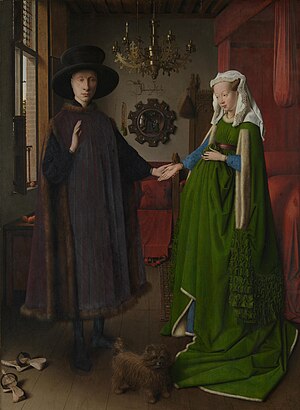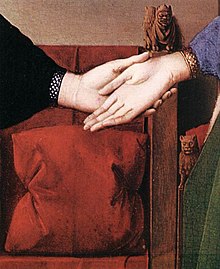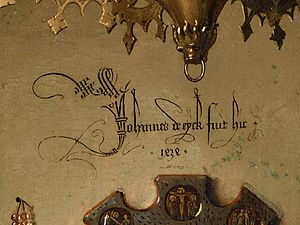Arnolfini wedding
The Arnolfini Wedding (also: Giovanni Arnolfini and his wife Giovanna Cenami or The Wedding of Giovanni Arnolfini ) is a painting by the Flemish painter Jan van Eyck . It was created in Bruges in 1434 and can now be viewed in the National Gallery in London .

|
| The Arnolfini wedding |
|---|
| Jan van Eyck , 1434 |
| oil on wood |
| 81.8 x 59.7 cm |
| National Gallery (London) |
background
The title of the picture was not known at first; it did not appear in an inventory until almost 100 years after its completion; It said: Large panel, Hernoult le Fin with his wife in one room . "Hernoult le Fin" was the French form of the Italian name "Arnolfini". The Arnolfinis were a large family of merchants and bankers who at the time had a branch in Bruges.
Image interpretation
In the picture, man and woman shake hands, at the same time the man has raised his right hand to take an oath, a typical gesture at the time during a marriage. More precisely, it is a morganatic marriage , also known as a marriage with the left hand (the scene makes it clear that Giovanni Arnolfini extends his left hand to his wife). This form of marriage was regularly used when two people of different status made a marriage vows. Her right hand is open in his left; that means she gives herself to him, he marries her. The hand of blessing and also the hand position of the man is comparable to analogous depictions of Jesus as ruler over the world in medieval frescoes. This is probably where Arnolfini's frontal depiction comes from.
It is not known whether the woman is pregnant. The curvature of her belly speaks for it, but it was quite typical for van Eyck and his contemporary painter colleagues to emphasize the fertility of women through this method of representation, without this being intended to indicate a pregnancy (at that time, the marriage of a woman was obviously pregnant Woman unthinkable anyway). Her graceful posture is Madonna-like and the color of her clothing - including white and blue - are Marian colors and therefore symbolize innocence and purity. The woman is probably not a portrait, but a Madonna-like idealization, whereby the facial features of the man can certainly be attributed to Giovanni Arnolfini. The woman's veil is another clue for marriage. In days gone by, married women wore their hair covered, as hair that was worn openly and uncovered was considered seductive.
Various symbols complete the picture:
- Clothing / inventory: it is a wealthy household. This becomes clear on the one hand through the fur-trimmed clothing made of precious flowing fabrics, and on the other hand through the inventory of the room: the glass window with partly colored hock panes , the Anatolian carpets and the orange fruits on the cupboard in front of the windowsill.
- Candle: Only one candle burns on the chandelier , because in the Middle Ages a large candle was usually carried in front of a wedding procession or presented to the bride by the groom. The single flame represents the all-seeing Christ, who is a witness when the marriage vows are made (cf. Eternal light in churches = presence of God). Candles themselves are another symbol of prosperity, as is the very elaborately designed brass chandelier.
- Dog: The dog is the symbol of marital fidelity, which can also be found on tombstones of married couples during this period. It is no coincidence that the animal is closer to the woman's feet, for unconditional fidelity is expected only from the woman.
- Floor: The apparently carelessly put down wooden clogs also have a symbolic content: “Don't step near, take your shoes off your feet, because the place you are standing on is a holy land” says the Old Testament of the Bible . If the sacrament of marriage was administered to two bride and groom , even a simple wooden floor was considered "holy land".
- Figure on the back of the chair: In the background on the right (barely recognizable next to the broom hanging on the wall) there is a chair back half hidden by the woman with a carved figure: It represents Saint Margaret , the patron saint of expectant mothers. The crystal-clear mirror and the transparent pearls of the prayer chain (forerunner of the rosary , hanging to the left of the mirror) speak for the purity of women .
- Round mirror in the background: the shape of the mirror is typical of the Middle Ages; With the technology of the time, mirrors could only be produced with rounded domes, because up until then all attempts to cast flat glass mirrors failed due to the fragility of the crystal plate. These mirrors were called witches because they broaden the viewing angle through their rounded vaults; Eyck has also incorporated this fascination into his painting (the witch on the back wall reflects the ceiling beams, which the straight line view of the picture does not reveal). You can also see in the mirror that there are other people standing in the door frame, possibly the witnesses for the marriage or the painter himself while he is recording the scene. The frame of the mirror is decorated with tiny passion scenes, another example of the richness of detail in van Eyck's pictures. The passion scenes may also have served to banish the witch mirror. If you also look at the other details in the room in the mirror, you will notice that the dog cannot be seen, although it should actually be visible in the mirror from this perspective.
The painter's signature is above the mirror. The painter has deviated from his usual formulation here: He did not write Johannes de Eyck fecit (= has done), but Johannes de Eyck fuit hic (= was here). It looks like Eyck was one of the witnesses to the wedding (another indication that one of the people in the mirror could be the painter himself). This gives the picture a kind of testimonial function, it becomes a receipt and thus a document of the wedding.
Late Gothic candlestick
A late Gothic chandelier identical to the one shown is described (with photo) in: The Art Monuments of the Canton of Zug . He could have been part of the Burgundy loot.
literature
Special studies
- Erwin Panofsky : Jan van Eyck's Arnolfini Portrait. (PDF; 3.4 MB) In: The Burlington Magazine 64 (1934), No. 372, pp. 117–127.
- Jean-Baptist Bedaux: The Reality of Symbols. The Question of Disguised Symbolism in Jan van Eyck's Arnolfini Portrait. In: Simiolus 16 (1986), pp. 5-28.
- Linda Seidel: Jan van Eyck's Arnolfini portrait. Business as Usual? In: Critical Inquiry 16 (1989), No. 1, pp. 54-86.
- Craig Harbison: Sexuality and Social Standing in Jan van Eyck's Arnolfini Portrait. In: Renaissance Quarterly 43 (1990), No. 2, pp. 249-291.
- Margaret D. Carroll: "In the Name of God and Profit". Jan van Eyck's Arnolfini portrait. In: Representations 44 (1993), pp. 96-132.
- Edwin Hall : The Arnolfini Betrothal. Medieval Marriage and the Enigma of van Eyck's Double Portrait. University of California Press, Berkeley, Los Angeles 1994.
- Jean-Philippe Postel: The Arnolfini case - In search of traces in a painting by Jan van Eyck. Octaves 1st edition 2017, ISBN 978-3-7725-3003-6
Presentation in overviews
- Newly exhibited painting by Van Eyck in the National Gallery in London . In: Illustrirte Zeitung . No. 15 . J. J. Weber, Leipzig October 7, 1843, p. 233 ( books.google.de ).
- Manfred Wundram : The most famous paintings in the world. Imprimatur, Bergisch Gladbach 1976.
- Wieland Schmied (Ed.): Harenberg Museum of Painting. 525 masterpieces from seven centuries. Harenberg, Dortmund 1999, ISBN 3-611-00814-1 .
- Rose-Marie Hagen, Rainer Hagen: Masterpieces in detail. Volume 2. Cologne 2003.
Web links
- Short video guide to the painting
- www.phil.uni-sb.de
- www.pm-magazin.de: The most beautiful love present from the Middle Ages ( Memento from December 11, 2005 in the Internet Archive )
- Van Eyck wedding? on LoSchermo.it (English)
Individual evidence
- ↑ Linus Birchler : The art monuments of the canton of Zug . Volume 2, 1959, pp. 453 and 454




